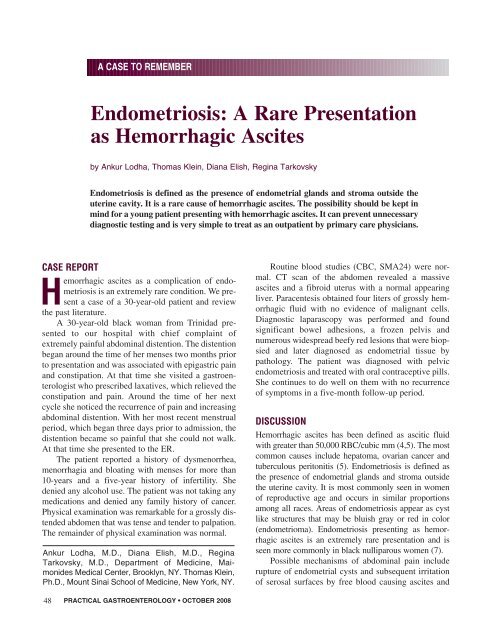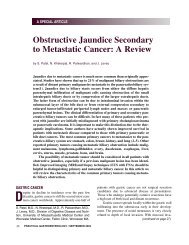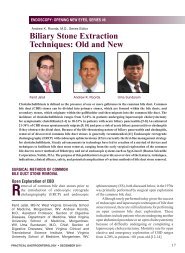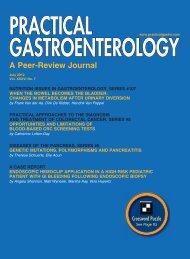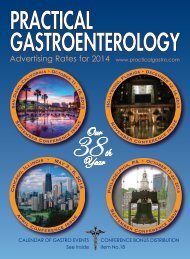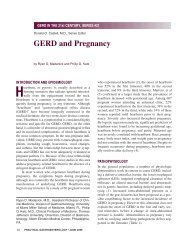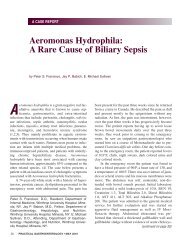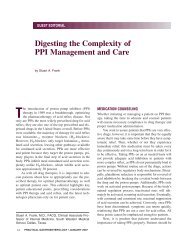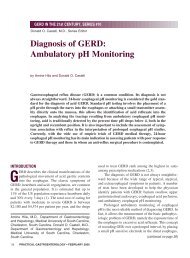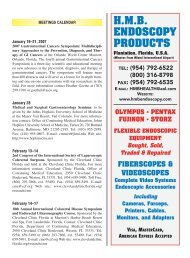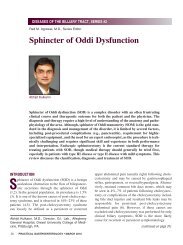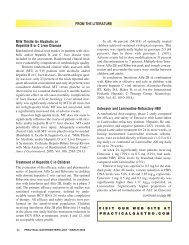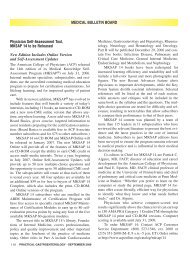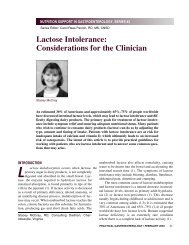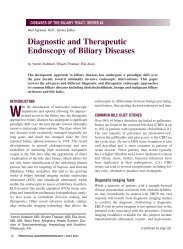Read Full Article - Practical Gastroenterology
Read Full Article - Practical Gastroenterology
Read Full Article - Practical Gastroenterology
Create successful ePaper yourself
Turn your PDF publications into a flip-book with our unique Google optimized e-Paper software.
A CASE TO REMEMBER<br />
Endometriosis: A Rare Presentation<br />
as Hemorrhagic Ascites<br />
by Ankur Lodha, Thomas Klein, Diana Elish, Regina Tarkovsky<br />
Endometriosis is defined as the presence of endometrial glands and stroma outside the<br />
uterine cavity. It is a rare cause of hemorrhagic ascites. The possibility should be kept in<br />
mind for a young patient presenting with hemorrhagic ascites. It can prevent unnecessary<br />
diagnostic testing and is very simple to treat as an outpatient by primary care physicians.<br />
CASE REPORT<br />
Hemorrhagic ascites as a complication of endometriosis<br />
is an extremely rare condition. We present<br />
a case of a 30-year-old patient and review<br />
the past literature.<br />
A 30-year-old black woman from Trinidad presented<br />
to our hospital with chief complaint of<br />
extremely painful abdominal distention. The distention<br />
began around the time of her menses two months prior<br />
to presentation and was associated with epigastric pain<br />
and constipation. At that time she visited a gastroenterologist<br />
who prescribed laxatives, which relieved the<br />
constipation and pain. Around the time of her next<br />
cycle she noticed the recurrence of pain and increasing<br />
abdominal distention. With her most recent menstrual<br />
period, which began three days prior to admission, the<br />
distention became so painful that she could not walk.<br />
At that time she presented to the ER.<br />
The patient reported a history of dysmenorrhea,<br />
menorrhagia and bloating with menses for more than<br />
10-years and a five-year history of infertility. She<br />
denied any alcohol use. The patient was not taking any<br />
medications and denied any family history of cancer.<br />
Physical examination was remarkable for a grossly distended<br />
abdomen that was tense and tender to palpation.<br />
The remainder of physical examination was normal.<br />
Ankur Lodha, M.D., Diana Elish, M.D., Regina<br />
Tarkovsky, M.D., Department of Medicine, Maimonides<br />
Medical Center, Brooklyn, NY. Thomas Klein,<br />
Ph.D., Mount Sinai School of Medicine, New York, NY.<br />
Routine blood studies (CBC, SMA24) were normal.<br />
CT scan of the abdomen revealed a massive<br />
ascites and a fibroid uterus with a normal appearing<br />
liver. Paracentesis obtained four liters of grossly hemorrhagic<br />
fluid with no evidence of malignant cells.<br />
Diagnostic laparascopy was performed and found<br />
significant bowel adhesions, a frozen pelvis and<br />
numerous widespread beefy red lesions that were biopsied<br />
and later diagnosed as endometrial tissue by<br />
pathology. The patient was diagnosed with pelvic<br />
endometriosis and treated with oral contraceptive pills.<br />
She continues to do well on them with no recurrence<br />
of symptoms in a five-month follow-up period.<br />
DISCUSSION<br />
Hemorrhagic ascites has been defined as ascitic fluid<br />
with greater than 50,000 RBC/cubic mm (4,5). The most<br />
common causes include hepatoma, ovarian cancer and<br />
tuberculous peritonitis (5). Endometriosis is defined as<br />
the presence of endometrial glands and stroma outside<br />
the uterine cavity. It is most commonly seen in women<br />
of reproductive age and occurs in similar proportions<br />
among all races. Areas of endometriosis appear as cyst<br />
like structures that may be bluish gray or red in color<br />
(endometrioma). Endometriosis presenting as hemorrhagic<br />
ascites is an extremely rare presentation and is<br />
seen more commonly in black nulliparous women (7).<br />
Possible mechanisms of abdominal pain include<br />
rupture of endometrial cysts and subsequent irritation<br />
of serosal surfaces by free blood causing ascites and<br />
48<br />
PRACTICAL GASTROENTEROLOGY • OCTOBER 2008
Endometriosis<br />
A CASE TO REMEMBER<br />
Figure 1. CT scan of abdomen demonstrating massive ascites.<br />
Figure 2. Laparoscopy showing hemorrhagic fluid in the<br />
peritoneal cavity.<br />
adhesions (1,2). Patients present most commonly with<br />
abdominal distention, dysmenorrhea, abdominal pain<br />
and anorexia (2). The ascitic fluid is typically exudative<br />
in nature (3).<br />
Diagnostic laparoscopy is the preferred technique<br />
to make an appropriate diagnosis. Biopsies should be<br />
taken and histologically analyzed if the diagnosis is<br />
questionable.<br />
Treatment options include estrogen-progesterone<br />
combination therapy and GnRH analogues (e.g. Danazol)<br />
that interrupt the cyclic ovarian hormone production.<br />
A six month course of medroxyprogesterone<br />
acetate is also apporopriate (6).<br />
A diagnosis of endometriosis should always be<br />
considered in a young patient of childbearing age who<br />
presents with hemorrhagic ascites. It is often forgotten<br />
Figure 3a and Figure 3b. showing epithelial cells with fibroconnective<br />
tissue and hemosiderin laden macrophages consistent<br />
with endometriosis.<br />
since the presentation (bloody ascites, weight loss and<br />
pelvic mass) can simulate malignancy. Hemorrhagic<br />
ascites secondary to endometriosis is a potentially<br />
treatable cause of bloody ascites. ■<br />
References<br />
1. Bernstein JP, Perlow V, Brenner JJ. Massive ascites due to<br />
endometriosis. Am J Dig Dis, 1961; 6:1-7.<br />
2. Dias CC, Andrade JM, et al. Hemorrhagic ascites associated with<br />
endometriosis. A case report. J Reprod Med, 2000; 45(8):688-<br />
690.<br />
3. Brosens IA. Endometriosis: Current isues in diagnosis and medical<br />
management. J Reprod Med, 1998; 43:281-286.<br />
4. Natelson EA, Allen TW, Riggs S, Fred HL. Bloody ascitis:diagnostic<br />
implications. Am J Gastroenterol, 1969; 52:523-527.<br />
5. Taub WH, Rosado S, et al. Hemorrhagic ascites secondary to<br />
endometriosis. J Clin Gastroenterol, 1989; 11:458-460.<br />
6. Naraynsingh V, Raju GC, Ratan P, Wong J. Massive ascites due<br />
to omental endometriosis. Postgrad Med J, 1985; 61:539-540.<br />
7. el-Newihi HM, Antaki JP, Rajan S, Reynolds TB. Large bloody<br />
ascites in association with pelvic endometriosis. Am J Gastroenterol,<br />
1995; 90:632-633.<br />
PRACTICAL GASTROENTEROLOGY • OCTOBER 2008 49


